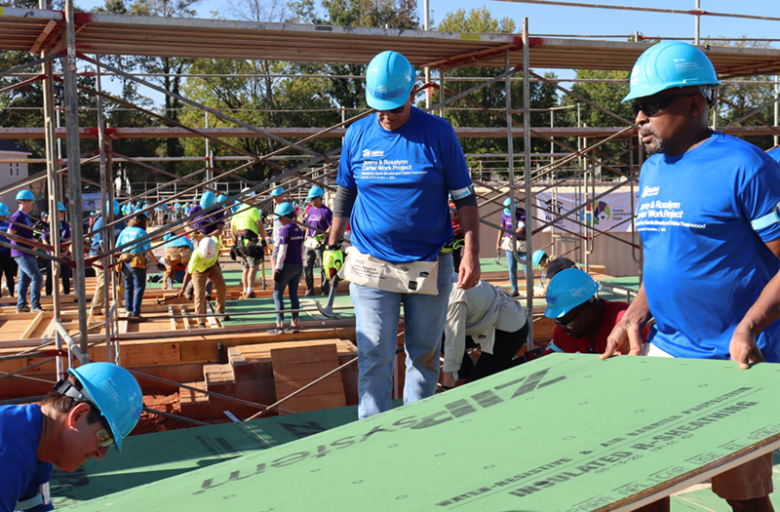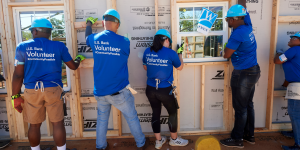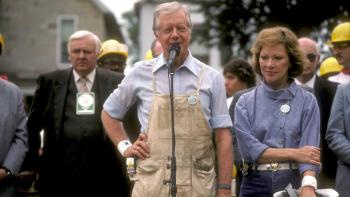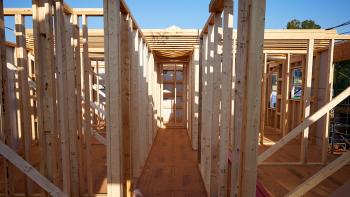Donate now to help communities impacted by Hurricanes Helene and Milton.
Support Habitat organizations in communities hit hard by recent hurricanes as we begin the long-term recovery work ahead.
Habitat for Humanity committed to long-term recovery of U.S. Southeast ahead of Hurricane Milton landfall
Carter Work Project 2024 house photos
Check out this year’s house photos, featuring homeowners and volunteers from the 2024 Carter Work Project in St. Paul, Minnesota.
2024 Carter Work Project recap
Watch highlights from the 40th Jimmy & Rosalynn Carter Work Project, where more than 4,000 participants came together during the weeklong event to celebrate President Carter’s 100th birthday while helping to build 30 homes in The Heights development in East St. Paul, Minnesota.
Thousands of volunteers gather in the Twin Cities to build 30 homes for Habitat for Humanity’s 38th Jimmy & Rosalynn Carter Work Project
Donate now to help communities impacted by Hurricane Helene
Help more than 150 local Habitat organizations in communities that have been impacted by deadly Hurricane Helene as we begin the long-term recovery work ahead.
Habitat for Humanity assesses damage, readies response in wake of Hurricane Helene
Raritan Valley HFH ReStore- Clinton
Investing in hope and home: U.S. Bank helps build affordable housing at Carter Work Project
U.S. Bank’s employees volunteer to help make a lasting difference in the lives of families building a place to call home during Habitat’s 2024 Carter Work Project.
Bill Carson looks forward to trading in his laptop for a hammer and nails as a volunteer at Habitat for Humanity’s 2024 Jimmy & Rosalynn Carter Work Project. The senior vice president at U.S. Bancorp Impact Finance, a subsidiary of U.S. Bank, will volunteer alongside 150 of his colleagues to help build homes at The Heights, an all-electric community where Twin Cities Habitat will build 130-150 affordable housing units.
Minneapolis-based U.S. Bank began participating in Carter Work Project in 2018, and Bill says it was such a fantastic experience they couldn’t wait to volunteer again.
To help support this year’s Carter Work Project, U.S. Bank and Habitat are participating in the federal New Markets Tax Credit Program, which helps incentivize private investment in distressed and disinvested communities across the country. U.S. Bancorp Impact Finance is contributing to Carter Work Project by investing in a US$6 million NMTC allocation administered by Habitat’s community development entity, and U.S. Bank is investing in a US$3.25 million NMTC allocation administered by USBCDE. The equity from both investments will help provide funding to build safe and sustainable Habitat homes in The Heights. U.S. Bank Corporate Social Responsibility and U.S. Bancorp Impact Finance are also contributing US$275,000 in philanthropic funding to Carter Work Project.

Bill Carson (far right) helps build affordable homes at Habitat’s 2023 Carter Work Project in Charlotte, North Carolina.
Bill sat down with Habitat to share more about what he’s most looking forward to during the Carter Work Project and why it’s important to U.S. Bank to help advance affordable housing in the Twin Cities.
What is your favorite task on the build site?
I’m not sure I have a favorite task. I think it’s just gratifying to see how far you can get over the course of a week with other volunteers working side by side with the homeowner to build something that’s going to change their family’s trajectory and potentially change the community’s trajectory over time. I think that’s my favorite part.
What are you packing for Carter Work Project?
Ibuprofen! That’s definitely something I’m packing. Compared to the regular days I have at the office and mostly sitting, even though I stay pretty active, it’s a very different thing to be on a construction site swinging a hammer and lugging things around. You are literally just sore. I will probably also bring kneepads this time, and I always have safety sunglasses for those sunny days.
Why is U.S. Bank excited to be a part of building Twin Cities Habitat’s affordable housing units at The Heights?
The Heights development is such an impactful project because it will redevelop an entire area of St. Paul, Minnesota, and bring back community. To build it from scratch, to have 150 affordable homeownership units alongside about 850 additional homes being built in that community, alongside new jobs, new parks, new businesses coming into that area and many other amenities for community residents – that made it especially exciting for us to get involved.
It doesn’t hurt also that it’s in U.S. Bank’s backyard. We’re especially interested in seeing redevelopment in that community given the fact that U.S. Bank’s headquarters are in Minneapolis and are deeply rooted in the Twin Cities area.
How do the goals for sustainability and creating more opportunities for under-resourced communities, especially communities of color, to become homeowners at The Heights align with the goals of the Habitat-U.S. Bank partnership to increase safe and affordable homeownership opportunities for all?
U.S. Bank is committed to environmental sustainability as part of the core of our company’s social responsibility and part of our overall growth targets. We know that sustainably built green homes improve health outcomes and save money for homeowners, and this is especially important for families with moderate incomes.
From the perspective of advancing homeownership, we recognize that there is a great opportunity for increasing homeownership among underrepresented communities, including Black and brown borrowers. Habitat has demonstrated through its Advancing Black Homeownership initiative that there really is a homeownership gap within the Minneapolis-St. Paul area. So we’re really thrilled that this aligns with U.S. Bank’s Access Capital initiatives.
What is fulfilling about getting out of the office and using your hands to help build homes?
It’s a lot of fun for me on a couple of levels. I’m actually an engineer, and I spent a long time in the early part of my career around industrial settings. And then I worked for a real estate developer for a period of time, too, so I had a chance to spend a lot of time around housing and housing construction. It’s kind of fun to get back to my roots in that regard.
The other piece is that it’s a great team-building exercise for us. It’s a lot of fun to get together with your colleagues and do something that is different than what we normally do. It’s not a conference call or working on a spreadsheet or even a typical team-building event. It’s something that is directly in service to other people and directly in service to another organizational partner like Habitat.

Investing in hope and home: U.S. Bank helps build affordable housing at Carter Work Project


